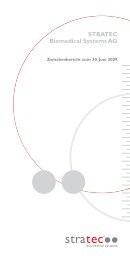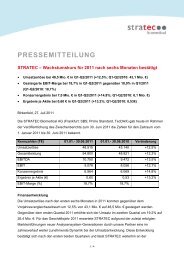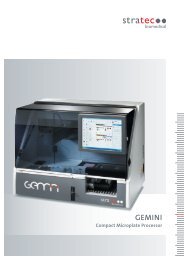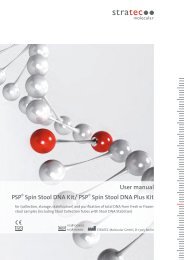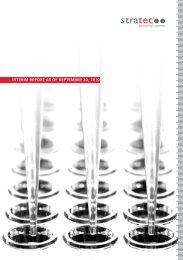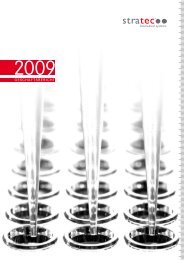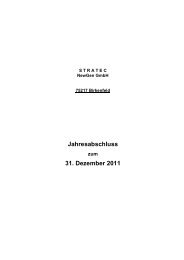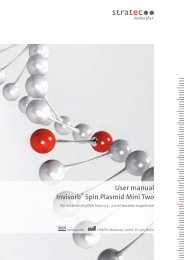annual Report 2009 - STRATEC Biomedical AG
annual Report 2009 - STRATEC Biomedical AG
annual Report 2009 - STRATEC Biomedical AG
Create successful ePaper yourself
Turn your PDF publications into a flip-book with our unique Google optimized e-Paper software.
The most important forward-looking assumptions and major sources of uncertainty concerning estimates at the balance<br />
sheet date, which involve a substantial risk of significant adjustments being required in the assets and liabilities thereby<br />
recognized within the coming financial year, are presented below:<br />
Discretionary decisions<br />
1. Recognition of internally generated intangible assets for development expenses pursuant to IAS 38<br />
Reference is made to the comments in Section II “Principles of the consolidated financial statements, 4. Accounting<br />
and valuation principles / Other intangible assets”.<br />
2. Methodology for determining revenue recognition using the percentage of completion method (POC)<br />
for order-related services pursuant to IAS 11<br />
stRATEC has to reach a discretionary decision for each individual order whether it represents a construction contract<br />
requiring revenue recognition in line with its percentage of completion using the POC method pursuant to IAS 11 or a<br />
sale of goods requiring revenue recognition only once all significant ownership risks have been transferred to customers<br />
pursuant to IAS 18. In terms of the production of analyzer systems, <strong>STRATEC</strong> <strong>AG</strong> assumes that its business model and<br />
the structure of individual contracts conform to IAS 11.3 except for cases where the contracts clearly involve sales of<br />
merchandise or maintenance services. In terms of customer-specific development services, <strong>STRATEC</strong> <strong>AG</strong> assumes<br />
that the requirements governing POC revenue recognition are currently not met.<br />
3. Allocation of goodwill to cash generating units (CGUs) for the purpose of impairment tests pursuant to IAS 36<br />
the allocation of the goodwill acquired upon the acquisition of Sanguin International Ltd., UK, to the “Sanguin Group”<br />
cash generating unit and of the goodwill acquired upon the acquisition of Invitek Gesellschaft für Biotechnik & Biodesign<br />
mbH, Berlin, to the “Automated Nucleic Acid Purification Applications” cash generating unit in both cases required<br />
substantial discretionary assessments to be made.<br />
Uncertainties involved in estimates<br />
1. Impairment tests on goodwill and current development projects<br />
The carrying amounts of goodwill and the principal assumptions underlying the impairment test performed as of the<br />
balance sheet date are presented in Section II “Principles of the consolidated financial statements”. Due to the large<br />
number of variables involved, this test requires a difficult and highly subjective discretionary decision to be made.<br />
the same applies for the impairment test performed as of the balance sheet date on the current development projects<br />
acquired with Invitek Gesellschaft für Biotechnik & Biodesign mbH, Berlin.<br />
the individual assumptions underlying the impairment tests are presented in Section II “Principles of the consolidated<br />
financial statements / 4. Accounting and valuation principles”. The sensitivity analyses performed in the context of<br />
goodwill impairment tests have been based on an assumed reduction in future cash flows and an assumed increase<br />
in weighted capital costs by 10 % in each case, as such variables would seem to be possible in the longer term. On<br />
this basis, we reached the conclusion that there were no indications of potential impairment in the goodwill at any<br />
cash generating unit. As in the previous year, the <strong>annual</strong> impairment test performed on cash generating units in the<br />
year under report did not result in the recognition of any impairment losses.<br />
2. Measurement of pension provisions using the projected unit credit method, taking due account of plan assets,<br />
and measurement of the defined benefit obligation pursuant to IAS 19.<br />
The measurement of the net defined benefit obligation requires forward-looking estimates to be made, especially<br />
when calculating interest rates and the development in the return on plan assets. Moreover, the measurement refers<br />
to biometrical assumptions based on past statistical values. The key assumptions have been subject to a sensitivity<br />
analysis presented in Section III “Disclosures relating to the balance sheet / (14) Provisions for pensions”.<br />
58 stratec Annual <strong>Report</strong> <strong>2009</strong>



